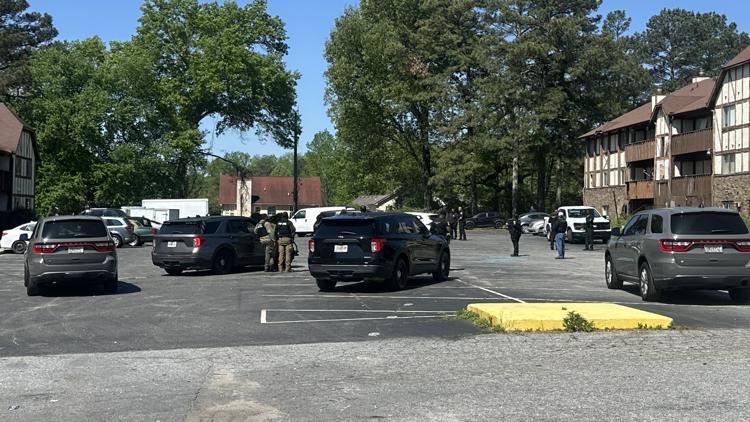Military's use of toxic 'forever chemicals' leaves lasting scars
This excerpt comes from the forthcoming book Poisoning the Well: How Forever Chemicals Contaminated America, which details how a set of toxic compounds have devastated entire communities across the country. It has been edited for length and clarity. Colorado Springs and its suburbs in El Paso County are surrounded not only by natural wonders like the Garden...

This excerpt comes from the forthcoming book Poisoning the Well: How Forever Chemicals Contaminated America, which details how a set of toxic compounds have devastated entire communities across the country. It has been edited for length and clarity.
Colorado Springs and its suburbs in El Paso County are surrounded not only by natural wonders like the Garden of the Gods, a massive park filled with red rock formations, but also several military installations, including Peterson Space Force Base, the US Air Force Academy, and the US Army’s Fort Carson.
Mark Favors grew up in the shadow of these bases, part of a tightly knit Black family within the largely White Colorado Springs.
As Mark tells it, Cold War–era patriotism molded the city into a libertarian stronghold in which the small-government ideology reigned and “politics was highly, highly, highly discouraged.”
Military service, on the other hand, was the bread and butter of the community, a major source of jobs in a rural region. The area is home to about 45,000 military personnel and 15,000 federal employees, as well approximately 90,000 veterans.
Mark’s family is no different. Today an ICU nurse in New York City, Mark is himself a veteran, as is his uncle and multiple other relatives. His large squadron of cousins, multiple-times-removed—some blood relations, and others not—have served in most branches of the military, leaving an intercontinental web of bootprints in their wake.
Likewise, his mom, Lillian Clark Favors, is a retired Air Force security manager, and his grandmother, Arletha, spent thirty-six years working as a civil servant at Fort Carson.
It is a staunchly patriot family—but one that has, in recent years, begun to question why this long history of military service seems to dovetail with an extensive pattern of disease.
Sitting at his mother’s dining room table in Colorado Springs, Mark attempted to tabulate exactly how many people in his extended family had suffered from various iterations of cancer and other sometimes-fatal illnesses. That headcount, he estimated, includes more than two dozen cousins, siblings, and in-laws—but does not even begin to touch upon the friends and neighbors who have similar stories.
“Another one of my cousins, he’s getting a port now,” Mark said, referring to the under-skin catheters used in kidney dialysis. At least five of his sick family members suffered from kidney-related diseases.
Mark has also noticed how tightly the illness tracks with proximity to certain bases. As far back as 1987, when his mother’s department was transferred from the older Ent Air Force Base, near downtown Colorado Springs, to a new building at Peterson Space Base, on the outskirts of the city, colleagues started falling ill.
A colonel in her group, Lillian remembered, decided to retire so that he would be able to take his grandson to kindergarten every day. “And then he got sick, and it was like, in two months, he was dead,” she said.
Most striking for Mark’s family, however, is the number of relatives who developed diseases after moving to Widefield, about five miles southwest of Peterson.
On retirement from the base, Mark’s grandmother decided to turn her hobby of making porcelain dolls into a second career and relocated to the suburb with her husband and son (Mark’s father) in the late 1970s.
Mark’s cousin Vikki recalled the moment when her grandmother pulled the family together one Thanksgiving in the late 1980s—with the news that her doctors had discovered a lump and that she was going to need surgery. Following the diagnosis and the surgery, Arletha went through a course of chemotherapy.
“And then she started having issues breathing,” Vikki continued.
Her cancer had returned. She succumbed to her illness on November 19, 1991, after about a week in the hospital.
“She just never was able to recover,” Vikki said.
Members of the immediate family who never moved from Colorado Springs to Widefield enjoyed long lives, several living into their nineties. Meanwhile, Arletha’s husband also died of cancer, and her son, who had no kidney issues prior to living in Widefield, developed renal failure and had a subsequent kidney transplant. But after the new kidney became cancerous, he too passed away, at the age of sixty-nine, in 2017.
Less than a year later, Mark was visiting his mother when a CBS This Morning special came on TV. As they watched an episode about perfluorochemicals—PFCs—Mark had an unsettling epiphany. “I just started doing more research into it,” Mark remembered, detailing how he began exploring Colorado state environmental mapping data.
PFCs, which today are known as PFAS, are a family of synthetic chemicals that have been used in a wide variety of household products from nonstick pans to waterproof clothing and cosmetics to fast food wrappers. These substances have also been linked to various cancers, kidney, liver and thyroid problems and immune system and fertility issues. They were also used for years in military-grade firefighting foam known as aqueous film-forming foam, or AFFF, which in many cases leached off of bases and into the water supplies of unsuspecting communities nearby.
Among Mark’s first moves was to talk to local politicians, as well as try to get his family’s water tested. Ultimately, Mark discovered that the Widefield property was contaminated with PFAS at levels that far surpassed the Environmental Protection Agency’s (EPA) drinking water health advisories at the time.

Several sets of groundwater samples taken just a half mile west of the property between 2016 and 2018 indicated that the area’s contamination was up to four times those safety thresholds. Rising from his seat at the dining table, Mark milled around the room and picked up a framed certificate that honored his mother for her four decades of service at Peterson.
Similar certificates are likely sitting in houses all over Colorado Springs, documenting not only years of service but years of exposure to toxic chemicals.
Members of the Favors family had no idea that the firefighting foam being used on nearby bases contained PFAS, or that those chemicals were dangerous, or that they were leaching into the local water supply.
But the military, like industry, already had some indication of AFFF’s toxic effects decades before such information became public knowledge.
In 1971, the Air Force Research Laboratory flagged the foam in use at the time—3M’s “Light Water”—as both a possible threat to certain fish and a “serious pollutant,” due to its inability to easily break down in water.
A few years later, Air Force researchers tested another iteration of Light Water and deemed it “less toxic” than previous PFAS-based foams, but still said it should not be released in substantial quantities if animals would be exposed for several days after the release.
In the same era, a 1975 report prepared by a contractor for the Defense Department affirmed that AFFF foams contain PFAS “which are largely resistant to biodegradation.”
Five years later, a Navy review suggested that AFFF shouldn’t be used in training at all, noting that it “may present serious environmental pollution problems” and that existing treatment facilities cannot process the substance.
Other problematic aspects of PFAS that are more widely known today, such as their toxic byproducts when PFAS are heated, were also noted in the 1970s and 1980s.
There did appear to be some knowledge gaps, however, including, as one naval commander put it in correspondence accompanying a 1978 report, 3M’s failure to disclose “any useful information” about the foam’s ingredients.
Nevertheless, a 1979 navy guide had also already listed “firefighting agents (e.g., AFFF)” as “hazardous.”
Meanwhile, a 1981 document went as far as raising legal concerns, flagging AFFF sludge for evaluation as potentially hazardous waste “to assess the Navy’s responsibility” under a waste cleanup law.
The knowledge soon trickled down to the installation level, with a 1985 report conducted at Peterson likewise describing AFFF as a “hazardous material,” though the report said that it did not produce hazardous waste.
In 1991, assessments from the Army Corps of Engineers conducted at Fort Campbell in Kentucky, Fort Ord in California, and Fort Carson in Colorado all recommended a transition to “nonhazardous substitutes.”
These warnings did have some effect—at least at select military installations. The Colorado Army base started using water rather than foam for training exercises in 1993, according to a Fort Carson spokesperson.
Subsequent policy allowed AFFF to be used only in emergencies, until the base replaced it entirely in 2018.
Meanwhile, neighboring Peterson took much longer to act—despite a 1989 internal analysis that demanded better management of AFFF waste.
But a central issue was that the air force simply has more planes on their installations than does the army on theirs, and jet fuel is particularly flammable when vaporized at high temperatures.
In fact, the Federal Aviation Administration for years required all airport firefighters to test their AFFF supplies—and until 2019, the foam was discharged into the environment.
Regardless of exactly why the military continued to use AFFF long after the hazards were known, the results were hard-hitting: in communities like Widefield, the firefighting foam flowed into the local water supply—and ultimately tainted residential taps.
To Mark Favors, that fact embodies the region’s symbiotic yet subservient relationship with the Defense Department, which he said has left a “trail of human devastation” in its path.
Given the extent of the contamination and the onslaught of illnesses that have rattled families across El Paso County, both Mark and his mother, Lillian, now look back at past years with newfound suspicion.
“It just kind of makes you wonder, as I say, did they know there was a problem from the beginning, when they started buying the foam or whatever?” Lillian asked. “Did they know?”
By November 2016, the US Army Corps of Engineers had detected PFAS at Peterson—noting that the chemicals “may present potential, non-carcinogenic risks to human health and the environment.”
Subsequent inspections, published the following year, found significant levels of PFAS in the groundwater at the base’s fire training area. Although no drinking water wells were immediately adjacent to that area, the “migration of PFAS-impacted groundwater offsite is possible and downgradient drinking water wells could be impacted,” the authors concluded.
Even down the I-25 highway at Fort Carson, the US Army base where AFFF hadn’t been used in more than three decades, the environment has remained contaminated both on and off the base itself.
At multiple spots cited in a January 2022 report, levels of several types of PFAS exceeded risk thresholds set by military leadership—who use those levels to determine the need for further investigation of a given site.
In response to the findings, a spokesperson said that the army would evaluate “the nature and extent of PFAS releases and conduct risk assessments using the latest EPA toxicity data.”
Such contamination is by no means limited to Colorado, but it has reached military families via vastly different pathways.
Peterson’s PFAS pollution has largely flowed into the faucets of off-installation communities downstream, while households on-base have benefited from clean drinking water supplied by Colorado Springs Utilities.
This was not necessarily the case on other Defense Department establishments: an internal memorandum showed that as of December 2019, the military served as the direct drinking water provider for about 175,000 people in twenty-four on-site neighborhoods in which levels of PFOA, PFOS, or both were considered unsafe.
After the EPA updated the levels that were considered safe in 2022, an advocacy organization called the Environmental Working Group estimated that 600,000 service members were imbibing contaminated water.
Meanwhile, blood tests issued to military firefighters over the past few years—as mandated by Congress—have revealed PFAS in virtually all samples.
At least one scathing assessment of the military’s behavior has come from within—from the inspector general (IG), an independent internal watchdog for the Defense Department.
In 2021, the watchdog dinged the military for declining to “proactively mitigate” risks related to AFFF, contrary to its own policies. While officials had issued a “risk alert” for the foam in 2011, that warning was never elevated, and administrators therefore did not have to respond—and they didn’t until 2016.
The watchdog also found “no evidence” that officials on bases, including firefighters, were made aware of the alert.
“As a result, people and the environment may have been exposed to preventable risks from PFAS‑containing AFFF,” the report said.
Richard Kidd, a high-ranking military official overseeing environmental issues, justified the behavior on the grounds that the military “learned about the health hazards posed by PFAS basically at the same pace as the rest of America.”
Only when the EPA issued a final health advisory in 2016 could the Defense Department “take objective, measurable actions,” he added.
Yet to many, the military’s actions are too little, too late.
Former Rep. Dan Kildee (D-Mich.), a vocal advocate for PFAS action, lamented in a March 2024 interview what he described as “the lack of urgency at the very top of the Defense Department” across presidential administrations.
Reached for comment in early 2024 under what was then the Biden administration, a spokesperson for the Pentagon’s leadership declined to answer a list of questions about the military’s use of AFFF, its early knowledge about the substance’s pollution potential, or suggestions that it should have been more proactive.

In the spring of 2019, the environment subpanel of the congressional House Oversight and Reform Committee began holding a series of hearings on PFAS. The first three sessions established scientific facts about the substances and featured witness testimony about the pervasiveness of the compounds.
They also included corporate voices who downplayed the public health risk, as Harley Rouda—a California Democrat and subcommittee chairman at the time—told his colleagues.
The goal of the fourth meeting, in November 2019, he explained, was to encourage “immediate federal action to regulate and cleanup these dangerous chemicals.”
Mark Favors was there to testify, revisiting his family’s painful experiences of cancer and death.
He spoke alongside actor Mark Ruffalo, who portrayed Rob Bilott, a lawyer who helped bring the PFAS issue into public view and represented contamination victims,in Dark Waters—a film that dramatized the lawyer’s fight against DuPont. Both Bilott and resident Bucky Bailey, born missing one nostril after his mother was exposed to PFOA from working at DuPont while pregnant, were sitting in the gallery during the testimonies.
At first, Mark Favors was confused as to why he, out of all PFAS activists, was chosen to speak alongside Ruffalo that day. But then he remembered the sheer number of cancer-related deaths that had stricken his family members, many of whom were veterans.
“Most of them survived either Korea, Vietnam, or Iraq, and they’re now in a military cemetery—not for combat wounds but for being poisoned by the military,” Mark said.
In addition to sharing his family’s experiences, Mark’s goal in testifying was to push for a congressional investigation into wrongdoing related to PFAS. At the helm of any such investigation, he believes, should be an impartial entity, independent of the Defense Department.
Mark noted that courts have held the air force accountable for other wrongs, like failing to notify the FBI about an assault conviction of a former serviceman. After that man went on to carry out a 2017 mass shooting, the air force had to pay $230 million to affected families.
But when it comes to contamination, the law dictates that the Department of Defense leads all investigations of pollution that begins on its property, rather than the EPA. And at this point, Mark’s confidence in the Defense Department has been badly shaken, to put it mildly.
During the November 2019 hearing, Republicans and Democrats alike professed a commitment to ensuring that American communities have access to clean, uncontaminated drinking water—although they had very different thoughts about how to get there.
Rep. James Comer (R-Ky.) cautioned against “taking any sweeping actions” that could harm the economy, while stressing that he does “wholeheartedly support if any families have been poisoned intentionally by corporate America that they get compensated for that.”
On the other side of the aisle, Rep. Alexandria Ocasio-Cortez (D-N.Y.) used most of her time to revisit Mark’s main points, reflecting on the notion that “the army has said this is dangerous.”
“That is why we need subpoenas issued for this and we need a comprehensive investigation from Congress,” Mark said in his testimony. “I concur. I concur with you, Mr. Favors,” the congresswoman agreed.

The military as a whole is evaluating hundreds of potentially polluted bases to see which might require PFAS cleanup. By the end of 2023, the Defense Department had assessed more than 700 bases and found that 574 of them needed remediation.
But such widespread restoration could take years — well into the 2030s for some bases and through 2048 for one particularly problematic site.
Nonetheless, the military was taking some intermediate cleanup steps at a small fraction of these polluted installations—just forty as of 2024—while the larger process played out. Amid the lucky locations were Peterson and Fort Carson.
Mark Favors has pressed on in hopes that one distant Hail Mary might rattle the scoreboard that has thus far indicated repeated defeat. After all, he explained, the mission of “taking on the Pentagon is not for the weak.”
He went so far as to chase down then-Sen. Kamala Harris (D-Calif.) after a PFAS-related hearing, upon remembering that Harris’s stepson had graduated from Colorado College in Colorado Springs in 2017.
“You remember when you went to your stepson’s graduation?” Mark asked her. “You know the creek behind Colorado College? . . . That’s all contaminated with PFAS.”
Following that revelation, he recalled, Harris’s “mouth literally hit the floor.”
What Mark would want from a congressional investigation, in theory, is quite simple. He would aim to “to find out what really happened, how pervasive is it, what can be done to prevent it.”
Another critical component would involve holding “people accountable if there was something nefarious, as the documents imply.”
A key reason behind the need for such an investigation, from Mark’s perspective, is the lack of legal recourse. Mark has faced repeated stumbling blocks in his quest “to get justice and accountability,” as he said in his 2019 congressional testimony.
What's Your Reaction?


























































